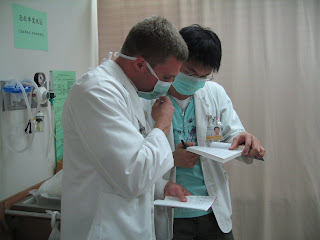
Day 22
June 22, 2009
Last week. Metabolism and Endocrinology . These cases prove to be complicated. Paul and I are partners. When we walked in the preceptor Dr. Chen seemed to be very pleased that we had come. He sat us down and knew a lot about us. Apparently he had studied our Curriculum Vitae. I felt like we needed to live up to our paper selves. We talked a bit about why we were interested in Taiwanese medicine and told him about Osteopathy.
There were two interns and a resident present as well. After an intern took a lengthy history from a patient, Dr. Chen asked me to do a physical exam. I took a deep breath and proceeded. Even though there was a language barrier with the patient I managed with the help of translating interns to cover most bases. I knew there was probably a problem with her thyroid or adrenal gland so I made sure to palpate her thyroid for thyromegaly just like Touro has taught us. I also completed an abdominal exam and musculo-skeletal and reflex exam. It turned out that these were important in discerning the disease process. It turns out that the complete general physical exam I learned at Touro has paid off as I was able to be efficient and thorough, surprising myself! This was my first physical exam I have performed on a real patient!
We only saw 3 patients the whole morning so we were able to ask lots of questions and dig deep into the knowledge bank of his mind. He asked us ‘pimp’ questions. We responded and analyzed. Americans are creative with their answers. Some people call it ‘creativity’ and some people call it ‘bs’ Or maybe we just talk more than our Taiwanese student counterparts.
During lunch we had a Doctor lecture about new diabetes management methods directly to us. This week it’s like we are enrolled directly in a course. Learning a lot.
In the afternoon we went to pathology conference. I asked a question at the round table to a bunch of senior doctors. Nerve racking, but good for me. I asked if Hashimotos Thyroiditis is connected to carcinoma. This question actually began a discussion amongst the doctors.
At the end of the day Dr. Chen gave us an introduction to thyroid issues, pathology, and diagnosis. This laid a nice base. He also gave us a tour of the research laboratory that he uses. We looked at some cell lines.
Catching up on sleep at night.
Day 23
June 23, 2009
At the hospital ward we joined a team of about 5 others for treatment of diabetic patients. Many patients have a ‘diabetic foot’ that needed amputation or other major procedures due to lack of blood flow. The attending physician on the team was kind enough to brief us about each case in English before going on rounds. We were given the opportunity to ask many questions. I think the Endrocrinology and Metabolism department looks at this as opportunity to help teach their staff and students English and the importance of international medicine. This department seems very excited about us being there and dedicated to teach us as much as possible. Also, they may hope to give their hospital a good name in the Americas. Regardless of the reason, it is a great learning experience.
In the afternoon, we went to the thyroid ultrasound examination room. When we first arrived the thyroid sonography appeared as a foreign language. After Paul and I examined each other’s thyroid with ultrasound and used the instrument on actual patients I know what a nodule and cyst look like on a thyroid ultrasound, and I can even maneuver the equipment. We also saw the doctor do many fine needle aspirations. He was a believer in hands-on training, but it’s probably a good thing we didn’t aspirate each other’s thyroid with big needles.
The preceptor was soft spoken but very patient, thorough, and organized with the method in which he taught us. He had a plan, and by the end I feel fairly confident with thyroid ultrasound diagnosis.
We went to Taipei to see a movie in the evening. Bonding time with the crew! I was in a giggly mood this night.










































